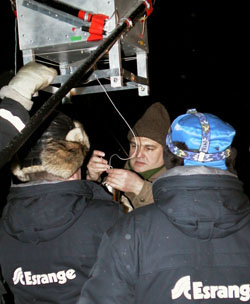Purpose of the flight and payload description
SKERRIES was a project developed to collect climatology information on the seasonal and year-to-year variability of stratospheric CFCs, water vapour and atmospheric electrical parameters by regular balloon flights from Esrange. It was a collaboration between the Swedish Institute of Physics, the Meteorological Institute at Stockholm University and the University of Cambridge.
Each flight transported several instruments onboard:
DESCARTES a lightweight instrument for the measurement of long-lived trace gases. The instrument was originally developed at the University of Cambridge. It was designed to fly piggyback on other payloads, with a low weight of about 16 kg and no need for telemetry. The instrument collected samples by letting a measured volume of air pass through a tube containing a Carboxen adsorbent. The measured species include CFC-11, CFC-113, CCl4 and CH3CCl3.
ERISKAY and EDAY two instruments aimed to measure atmospheric and magnetospheric electric fields. The first one was a 4-probe instrument to measure all 3 vector components of the electric field, incorporating also a 3-axis magnetometer. It was designed to measure the atmospheric (vertical) electric field during ascent and descent and the magnetospheric (horizontal) electric field at float. The Second one was a simpler version which measured only the atmospheric vertical electric field, at heights above the tropopause.
MARTIN an acoustic balloon-borne instrument to measure temperature fine structure near the tropopause developed by IRF and the Technical University Graz. It made use of the fact that the speed of sound is to a very good approximation proportional to the square root of temperature. The instrument provided a basic time resolution of over 700 Hz and 1 mK in temperature.
An optical HYGROMETER for nighttime use originally built at the Atmospheric Physics group at Stockholm University. It was usually flown on sounding rockets but also participated in SKERRIES balloon flights.
Details of the balloon flight
Balloon launched on: 12/11/2000 at 14:09 utc
Launch site: European Space Range, Kiruna, Sweden
Balloon launched by: Swedish Space Corporation (SSC)
Balloon manufacturer/size/composition: Zero Pressure Balloon
Flight identification number: SKERRIES 8
End of flight (L for landing time, W for last contact, otherwise termination time): 12/11/2000 at 16:15 utc
Balloon flight duration (F: time at float only, otherwise total flight time in d:days / h:hours or m:minutes - ): ~ 2 h
Landing site: E of Kittilä, Finland
Campaign: SKERRIES
The balloon was launched on Monday, December 12th, 2000 from the balloon launch pad of ESRANGE near Kiruna, Sweden at 14:09 UTC. Total flight time was approximately 2 hours. Winds carried the ballon in an south-easternly direction until cut-down command was sent at 16:15 UTC. The payload landed east of the town of Kittilä in the north-east part of Finland.
External references
- Calibration and quality assessment of DESCARTES: grabsampler for stratospheric tracers Doctoral thesis by Arvelius, Johan, Umeå University, Faculty of Science and Technology, Space Science (2005
- List of balloons launched from ESRANGE SSC Space website (via Archive.Org)
1375If you consider this website interesting or useful, you can help me to keep it up and running with a small donation to cover the operational costs. Just the equivalent of the price of a cup of coffee helps a lot.



